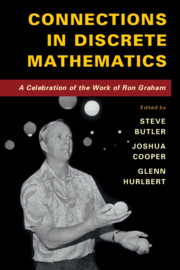Book contents
- Frontmatter
- Contents
- List of Contributors
- Preface
- 1 Probabilizing Fibonacci Numbers
- 2 On the Number of ON Cells in Cellular Automata
- 3 Search for Ultraflat Polynomials with Plus and Minus One Coefficients
- 4 Generalized Gončarov Polynomials
- 5 The Digraph Drop Polynomial
- 6 Unramified Graph Covers of Finite Degree
- 7 The First Function and Its Iterates
- 8 Erdős, Klarner, and the 3x + 1 Problem
- 9 A Short Proof for an Extension of the Erdős–Ko–Rado Theorem
- 10 The Haight–Ruzsa Method for Sets with More Differences than Multiple Sums
- 11 Dimension and Cut Vertices: An Application of Ramsey Theory
- 12 Recent Results on Partition Regularity of Infinite Matrices
- 13 Some Remarks on π
- 14 Ramsey Classes with Closure Operations (Selected Combinatorial Applications)
- 15 Borsuk and Ramsey Type Questions in Euclidean Space
- 16 Pick's Theorem and Sums of Lattice Points
- 17 Apollonian Ring Packings
- 18 Juggling and Card Shuffling Meet Mathematical Fonts
- 19 Randomly Juggling Backwards
- 20 Explicit Error Bounds for Lattice Edgeworth Expansions
- References
8 - Erdős, Klarner, and the 3x + 1 Problem
Published online by Cambridge University Press: 25 May 2018
- Frontmatter
- Contents
- List of Contributors
- Preface
- 1 Probabilizing Fibonacci Numbers
- 2 On the Number of ON Cells in Cellular Automata
- 3 Search for Ultraflat Polynomials with Plus and Minus One Coefficients
- 4 Generalized Gončarov Polynomials
- 5 The Digraph Drop Polynomial
- 6 Unramified Graph Covers of Finite Degree
- 7 The First Function and Its Iterates
- 8 Erdős, Klarner, and the 3x + 1 Problem
- 9 A Short Proof for an Extension of the Erdős–Ko–Rado Theorem
- 10 The Haight–Ruzsa Method for Sets with More Differences than Multiple Sums
- 11 Dimension and Cut Vertices: An Application of Ramsey Theory
- 12 Recent Results on Partition Regularity of Infinite Matrices
- 13 Some Remarks on π
- 14 Ramsey Classes with Closure Operations (Selected Combinatorial Applications)
- 15 Borsuk and Ramsey Type Questions in Euclidean Space
- 16 Pick's Theorem and Sums of Lattice Points
- 17 Apollonian Ring Packings
- 18 Juggling and Card Shuffling Meet Mathematical Fonts
- 19 Randomly Juggling Backwards
- 20 Explicit Error Bounds for Lattice Edgeworth Expansions
- References
Summary
Abstract
This chapter describes work of Erdőss, Klarner, and Rado on semigroups of integer affine maps and on sets of integers they generate. It gives the history of problems they studied, some solutions, and new unsolved problems that arose from them.
Introduction
This chapter describes the history of an Erdőss problem on iteration of integer affine functions, gives its solution, and tours some related work. An integer affine function of one variable is a function of the form f (x) = mx + b for integers m, b. The Erdőss problem concerns the structure of integer orbits of a particular finitely generated semigroup of integer affine functions, with the semigroup operation being composition of maps.
In the early 1970s David Klarner and Richard Rado studied integer orbits of semigroups of such affine functions in an arbitrary number of variables, motivated by the work of Crampin and Hilton on self-orthogonal Latin squares described in the text that follows. In response to a question they posed about a particular example, Paul Erdőss proved a theorem on the size of an orbit for certain semigroups of univariate functions, upper bounding the number of integers below a given cutoff T occurring in such orbits, cf. [37, Theorem 8]. Erdős's interest in this orbit problem led him to offer a reward for a particular semigroup iteration problem. This problem was solved by Crampin and Hilton in 1972, but their solution was never published. We supply a reconstructed solution here.
We also present a history of selected later developments, including work of Mike Fredman, Don Knuth, David Klarner, and Don Coppersmith. Their work addresses the structure of particular affine integer semigroups, and sufficient conditions for an integer affine semigroup to be freely generated. The latter topic led Klarner to pose in 1982 several easy-to-state problems in the spirit of Erdős's prize problem, given at the end of the chapter, which remain unsolved.
- Type
- Chapter
- Information
- Connections in Discrete MathematicsA Celebration of the Work of Ron Graham, pp. 139 - 168Publisher: Cambridge University PressPrint publication year: 2018



